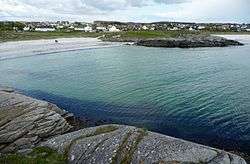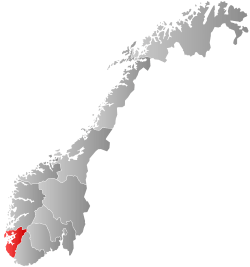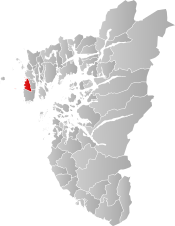Åkra
Åkra is a former municipality in the traditional district of Haugaland in Rogaland county, Norway. The 33-square-kilometre (13 sq mi) municipality existed from 1892 until 1965 and it encompassed the central part of the western coast of the island of Karmøy. The administrative centre was the village of Åkrehamn.[2]
Åkra herred Aakra herred (historic) | |
|---|---|
 View of the Åkra coastline | |
 Rogaland within Norway | |
 Åkra within Rogaland | |
| Coordinates: 59°15′30″N 05°10′55″E | |
| Country | Norway |
| County | Rogaland |
| District | Haugaland |
| Established | 1 Jan 1892 |
| Disestablished | 1 Jan 1965 |
| Administrative centre | Åkrehamn |
| Area | |
| • Total | 33 km2 (13 sq mi) |
| *Area at municipal dissolution. | |
| Population (1965) | |
| • Total | 6,008 |
| • Density | 180/km2 (470/sq mi) |
| Demonym(s) | Åkrabu[1] |
| Time zone | UTC+01:00 (CET) |
| • Summer (DST) | UTC+02:00 (CEST) |
| ISO 3166 code | NO-1149 |
| Preceded by | Skudenes in 1892 |
| Succeeded by | Karmøy in 1965 |
History
The municipality of Aakra was established on 1 January 1892 when it was split off from the municipality of Skudenes. Initially, the new municipality had a population of 1,962. On 1 January 1965, the municipality of Åkra was dissolved due to recommendations by the Schei Committee. Åkra was merged with the neighboring municipalities of Avaldsnes, Skudenes, Stangaland, and Torvastad and with the towns of Kopervik and Skudeneshavn to form the new, larger municipality of Karmøy. Before the merger Åkra had a population of 6,008.[3]
Attractions
The Old Åkra Church (Åkra gamle kyrkje) dates back to 1821. It was built of wood and has 320 seats. The church was restored in 1852 and 1899. Rogaland Fishery Museum (Rogaland Fiskerimuseum) is situated on the harbor in Åkrahamn. It contains a restored herring works with a collection of artifacts and equipment associated with the local fishing and shipping industries.[4][5]
Government
All municipalities in Norway, including Åkra, are responsible for primary education (through 10th grade), outpatient health services, senior citizen services, unemployment and other social services, zoning, economic development, and municipal roads. The municipality is governed by a municipal council of elected representatives, which in turn elects a mayor.[6]
Municipal council
The municipal council (Herredsstyre) of Åkra was made up of representatives that were elected to four year terms. The party breakdown of the final municipal council was as follows:
| Party Name (in Norwegian) | Number of representatives | |
|---|---|---|
| Local List(s) (Lokale lister) | 25 | |
| Total number of members: | 25 | |
| Party Name (in Norwegian) | Number of representatives | |
|---|---|---|
| Labour Party (Arbeiderpartiet) | 8 | |
| Local List(s) (Lokale lister) | 17 | |
| Total number of members: | 25 | |
| Party Name (in Norwegian) | Number of representatives | |
|---|---|---|
| Labour Party (Arbeiderpartiet) | 4 | |
| Local List(s) (Lokale lister) | 21 | |
| Total number of members: | 25 | |
| Party Name (in Norwegian) | Number of representatives | |
|---|---|---|
| Labour Party (Arbeiderpartiet) | 6 | |
| Local List(s) (Lokale lister) | 10 | |
| Total number of members: | 16 | |
| Party Name (in Norwegian) | Number of representatives | |
|---|---|---|
| Labour Party (Arbeiderpartiet) | 6 | |
| Joint List(s) of Non-Socialist Parties (Borgerlige Felleslister) | 8 | |
| Local List(s) (Lokale lister) | 2 | |
| Total number of members: | 16 | |
| Party Name (in Norwegian) | Number of representatives | |
|---|---|---|
| Labour Party (Arbeiderpartiet) | 6 | |
| Local List(s) (Lokale lister) | 10 | |
| Total number of members: | 16 | |
| Party Name (in Norwegian) | Number of representatives | |
|---|---|---|
| Labour Party (Arbeiderpartiet) | 6 | |
| Joint List(s) of Non-Socialist Parties (Borgerlige Felleslister) | 9 | |
| Local List(s) (Lokale lister) | 1 | |
| Total number of members: | 16 | |
References
- "Navn på steder og personer: Innbyggjarnamn" (in Norwegian). Språkrådet.
- Store norske leksikon. "Åkra – tidligere kommune" (in Norwegian). Retrieved 2015-10-30.
- Jukvam, Dag (1999). "Historisk oversikt over endringer i kommune- og fylkesinndelingen" (PDF) (in Norwegian). Statistisk sentralbyrå.
- "Karmøy". GoNorway.com.
- Falkeid, Kolbein (1999). Haugalandet: Ferd i folk og natur. Wigestrand Forlag.
- Hansen, Tore, ed. (2016-05-12). "kommunestyre". Store norske leksikon (in Norwegian). Kunnskapsforlaget. Retrieved 2020-07-13.
- "Kommunevalgene 1963" (PDF) (in Norwegian). Oslo: Statistisk sentralbyrå. 1964. Retrieved 2020-07-14.
- "Kommunevalgene og Ordførervalgene 1959" (PDF) (in Norwegian). Oslo: Statistisk sentralbyrå. 1960. Retrieved 2020-07-14.
- "Kommunevalgene og Ordførervalgene 1955" (PDF) (in Norwegian). Oslo: Statistisk sentralbyrå. 1957. Retrieved 2020-07-14.
- "Kommunevalgene og Ordførervalgene 1951" (PDF) (in Norwegian). Oslo: Statistisk sentralbyrå. 1952. Retrieved 2020-07-14.
- "Kommunevalgene og Ordførervalgene 1947" (PDF) (in Norwegian). Oslo: Statistisk sentralbyrå. 1948. Retrieved 2020-07-14.
- "Kommunevalgene og Ordførervalgene 1945" (PDF) (in Norwegian). Oslo: Statistisk sentralbyrå. 1947. Retrieved 2020-07-14.
- "Kommunevalgene og Ordførervalgene 1937" (PDF) (in Norwegian). Oslo: Statistisk sentralbyrå. 1938. Retrieved 2020-07-14.

